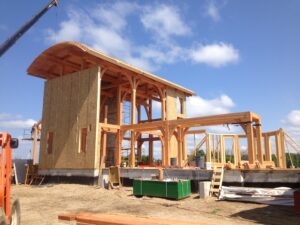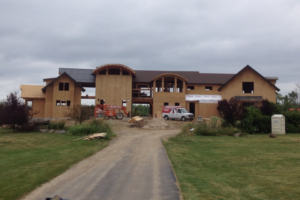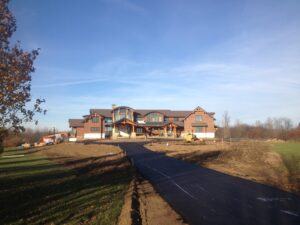
When it comes to building a natural, rustic home that blends beauty with durability, two time-tested methods often come to mind: timber framing and log home construction. Both approaches
celebrate wood in its most expressive form, offering character and charm that modern stick-built homes can’t quite match. However, if you’re deciding between the two, timber framing offers several distinct advantages that make it the superior choice for many homeowners.
Aesthetics with Flexibility
Log homes make a bold statement—but that statement comes with design limitations. Walls made entirely of stacked logs define the interior look, leaving less room for creative architectural expression. In contrast, timber frames use large wooden posts and beams to form a structural skeleton, which allows for open floor plans and diverse wall materials. You get the warmth and grandeur of exposed wood without sacrificing personal style. Timber frames pair beautifully with stone, glass, drywall, or reclaimed materials, letting you design your home inside and out with more flexibility.

Superior Energy Efficiency
Log homes are often touted for their natural insulation properties, but they also come with challenges—settling, shrinkage, and the need for meticulous sealing between logs. Timber frame homes, however, are typically insulated with Structural Insulated Panels (SIPs), which provide an airtight, energy-efficient envelope. The result? A home that stays warmer in the winter, cooler in the summer, and costs less to heat and cool year-round.
Structural Integrity That Lasts
Both log and timber frame homes can last for centuries if properly maintained, but timber frames have a structural edge. Because they rely on a central frame rather than stacked logs for support, timber-framed buildings experience less settling and shifting over time. Joinery techniques—many borrowed from centuries-old European traditions—make these homes incredibly strong, able to withstand heavy snow loads, high winds, and even earthquakes.
Easier Maintenance
Log homes require regular maintenance to prevent rot, insect infestation, and UV damage. The entire exterior must be cleaned and resealed every few years, and any gaps or cracks in the logs must be carefully managed. Timber frame homes, with their non-log exterior walls, avoid most of these headaches. Maintenance is more similar to a conventional home, with less frequent and less intensive upkeep required.
Timeless Craftsmanship

One of the most compelling reasons to choose a timber frame home is the artistry involved. From hand-cut mortise and tenon joints to the graceful curves and pegs that define traditional timber construction, each frame is a unique expression of craftsmanship. Log homes can be beautiful, but timber frames elevate wood to a structural and architectural art form.
In Conclusion
Log homes and timber frame homes both have their place in the world of natural building, but timber frames offer a blend of strength, beauty, energy efficiency, and design freedom that’s hard to match. Whether you’re building a mountain retreat, lakeside getaway, or a full-time family home, timber framing offers the kind of long-lasting value and timeless appeal that will serve generations to come.
Timbercraft can help create your dream timber frame contact us for a free proposal and we can start you on your way to building your perfect get away. (734) 864-9790 or [email protected]
